PAPER 1
THEORY
SECTION A
Answer all questions in this section. For each question select the most correct option and write the letter representing it in the box provided.
1. What would happen to an enzyme if the temperature of its medium was increased to above 500c? the enzyme would be
A. Killed
B. Activated
C. Denatured
D. Inactivated
2. In which of the following does active transport not occur?
A. Kidney tubules
B. Phloem sieve tubes
C. Xylem vessels
D. Ileum Villi
3. Which one of the following is adaptation of reptiles for terrestrial environment?
A. Limbs
B. Lungs
C. Scales
D. Elongated body
4. Figure 1 below shows a longitudinal section through a maize grain.
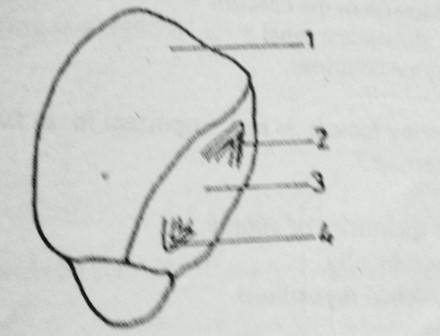
Which of the parts 1 - 4 of the grain would you expect to decrease in weight during germination?
A. 1
B. 2
C. 3
D. 4
5. Which one of the following parts of the ear, transmits sound waves from the middle ear to the inner ear?
A. Tympanic membrane
B. Ossicles
C. Auditory nerve
D. Oval window membrane
6. Which one of the following methods would you use to estimate the frequency of a plant species in area?
A. Quadrant method
B. Belt transect
C. Line transect
D. Random sampling
7. An unknown sample of blood was found to agglutinate with blood of group AB, but not with blood of O. what was the blood group of the unknown sample?
A. O
B. AB
C. A
D. B
8. A rabbit is able to utilize cellulose because it
A. Has symbiotic bacteria in the stomach
B. Has symbiotic bacteria in the ceacum
C. Has a very long alimentary canal
D. Secretes the enzyme cellulose
9. Which one of the following factors is not important as far as nutrition of the common mould is concerned?
A. It produces large quantities of spores.
B. It can respire anaerobically.
C. It has a highly branched mycelium.
D. It secrets enzymes.
10. In the human heart, the mixing of oxygenated and de-oxygenated blood is prevented by the
A. Septum,
B. Bicuspid valve,
C. Tricuspid valve,
D. Semilunar valve.
11. Removal of the thyroid gland in a young child may lead to
A. Stunted growth and mental retardation.
B. Failure to develop secondary sexual characteristics.
C. Development of diabetes
D. Increased metabolic rate and restlessness.
12. The following are physiological processes that occur in the body of a mammal.
(i) Elimination of urea
(ii) Regulation of salts in the body
(iii) Regulation of water in the body
(iv) Deamination of excess amino acids.
Which of them are carried out by the kidney?
A. (i), (ii) and (iv)
B. (ii), (iii) and (iv)
C. (i), (ii) and (iii)
D. (ii) and (iii) only
13. Which one of the following is a respiratory organ in an insect?
A. Malphigian tubule
B. Spiracle
C. Trachea
D. Zygote
14. Which one of the following is a diploid cell?
A. Pollen grain
B. Ovum
C. Spermatoon
D. Alveolus
15. What gas is likely to be evolved from a submerged aquatic plant placed in bright sunlight?
A. Carbon dioxide
B. Oxygen
C. Hydrogen
D. Nitrogen
16. Which of the following is a characteristic of cervical vertebra?
A. Broad neutral spine
B. Long transverse processes
C. Presence of vertebraterial canals
D. Presence of facets
17. Which one of the following has the least energy content in a food chain?
A. Producer
B. Secondary consumer
C. Tertiary consumer
D. Primary consumer
18. A certain plant had the following characteristics:
Leaves reduced to spikes
Stomata shrunken in pits
Leaves covered with thick cuticle
Which one of the following would be the likely habitat for the plant?
A. Open grass land
B. Arid land
C. Wet land
D. Tropical rainforest
19. Yellowing of leaves in growing maize plants indicates a deficiency of
A. Calcium
B. Sulphur
C. Nitrogen
D. Magnesium
20. What are the products of digestion of lactose sugar?
A. Glucose only
B. Glucose and Galactose
C. Fructose and Galactose
D. Fructose and glucose
21. Which one of the following is a characteristic of insects only?
A. Exoskeleton
B. Jointed legs
C. Two pairs of wings
D. Three body divisions
22. Which of the following vegetative plants would appear earliest in a rocky habitat?
A. Moss
B. Lichens
C. Algae
D. Ferns
23. Which one of the organisms below has a growth curve represented by the graph in figure 2?
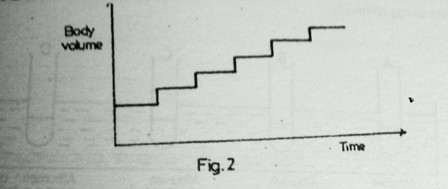
A. A bacterium
B. An insect
C. A human being
D. A bony fish
24. Which one of the following is a modified root?
A. Sweet potato tuber
B. Rhizome
C. Irish potato tuber
D. Corm
25. Which one of the following hormones is responsible for ovulation in mammals?
A. Oestrogen
B. Progesterone
C. Follicle stimulating hormone
D. Luteinizing hormone
26. Which of the following are characteristics of sandy soil?
A. Poor aeration and poor drainage.
B. Good water retention and poor drainage.
C. Sticky when wet and poor drainage.
D. Good aeration and good drainage.
27. Which of the following is not true about mutation?
A. Mutation may affect single genes or chromosomes.
B. All mutations produce harmful effects.
C. A mutant gene can be passed onto the offspring during fertilization
D. Mutations are the raw materials for evolution.
28. A maize grain is both a seed and a fruit because it
A. shows hypogeal germination
B. has a fused pericarp and testa
C. shows two attachments or scars
D. has both endosperm and cotyledon.
29. Figure 3 below is an experimental set up to investigate the action of enzyme pepsin on egg albumen.
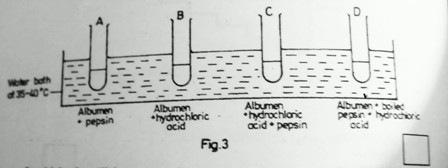
In which tube will the contents clear after some time?
30. Which one of the following substances does not contain nitrogen?
A. Glycerol
B. Amino acids
C. Amylase
D. Urea
SECTION B
Answer all questions in this section. Answer must be written in the spaces provided.
31. Figure 4 below, shows a mammalian urinary system.
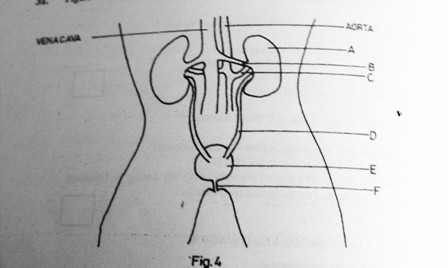
a) Name the parts labelled A - F.
A ........................................................... D .................................................
B ........................................................... E ..................................................
C ........................................................... F ..................................................
b) Briefly explain why the concentration of urea in B is less than that in C.
c) What is the function of E?
d) A sample of urine was found to contain sugar.
(i) Suggest the type of sugar likely to be contained in the urine sample.
(ii) What hormone is likely to be deficient in the person from whom the urine sample was taken?
(iii) Name the disease that the person is likely to be suffering from.
e) Another individual was found to be passing out a lot of urine but without sugar and complaining of thirst most of the time.
(i) Suggest a hormone that is deficient in this individual.
(ii) Name the organ which produces the hormone referred to in (e) (i) above.
32. a) Give five differences between respiration and photosynthesis.
b) Give three ways in which respiration is important to living organisms.
c) Name two commercial uses of anaerobic respiration.
33. a) What is germination?
b) State the external factors that affect germination.
c) Figure 5 below shows a growth curve of a bean seedling.
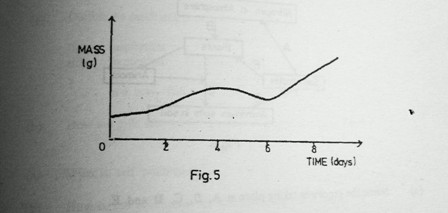
(i) Why does the mass of the seedling increase between day 0 and day 4?
(ii) What has caused a drop in the mass between day 4 and day 6?
(iii) Give reason for the steady increase in mass after day 6.
34. Figure 6 below shows the nitrogen cycle.
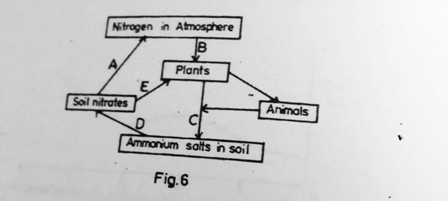
a) Name the processes taking place at A, B, C, D and E.
A .............................................................................................................
B .............................................................................................................
C .............................................................................................................
D ............................................................................................................
E ............................................................................................................
b) (i) How is the process at B useful to plants?
(ii) What organisms are responsible for the process at C?
c) State the importance of the process at A in the cycle.
SECTION C
Answer any two questions.
35. a) outline the mechanism of
(i) inspiration
(ii) expiration
in a bony fish
b) How are grills adapted for gaseous for exchange in a bony fish?
36. a) What is self pollination?
b) How is self pollination naturally prevented in plants?
c) Describe the features of a flower that favour pollination by insects.
37. a) Giving tow examples in each case, explain the following:
(i) parasitism
(ii) commensalism
(iii) symbiosis
b) How is the tape worm adapted to its parasitic mode of life?
38. a) What is transpiration?
b) Describe an experiment to show that transpiration occurs in plants.
c) State the factors that effect transpiration in plants.
